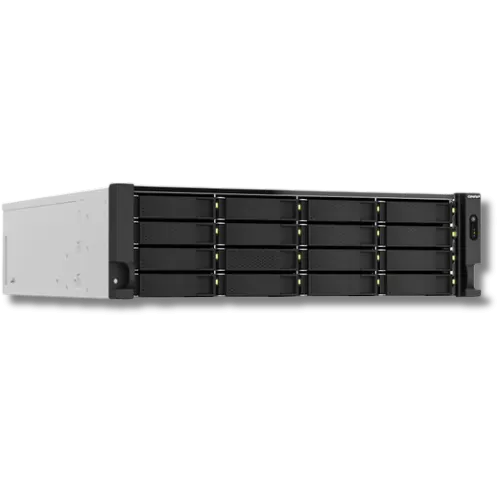A marketing agency in New York contacted us after its QNAP QuTS hero NAS failed without warning. The system held live client data vital to ongoing campaigns, and the sudden loss of access caused immediate disruption to day-to-day operations.
The agency’s in-house team found the NAS was no longer reachable over the network and none of the shared folders could be accessed.
With deadlines and client communications at risk, QNAP NAS data recovery became the top priority. We mobilised quickly to stabilise the drives, secure clean images and prepare for controlled reconstruction.

Client Situation: RAID 10 Array Unavailable
The QNAP QuTS hero NAS was configured as a ZFS RAID 10, selected to deliver a balanced mix of throughput and resilience for high-demand workloads.
Despite that architecture, the system became unresponsive, blocking access via both the network and the local management interface.
The in-house team tried first-line checks, including controlled reboots and port verification, but the member disks remained unreadable. With live project assets offline, several campaigns were paused pending QNAP NAS data recovery and controlled access restoration.
Initial Troubleshooting and Risk Recognition
Before engaging us, the agency’s IT team undertook a series of first-line recovery actions on the QNAP QuTS hero NAS:
System reboot and drive reseating: Multiple restarts and careful reseating of the disks to prompt the array to come back online.
Firmware review: Checked for the latest QNAP firmware and attempted an update. The NAS remained unreachable.
Manual RAID import: Tried to import the ZFS RAID 10 pool via the console, but the pool would not mount.
Third-party utilities: Tested tools to see individual disks, yet no valid file system structure was detected.
After multiple failed attempts, the agency recognised that further DIY recovery could permanently damage ZFS metadata or overwrite valid parity data.
They reviewed our article on RAID rebuild data loss risks and decided to proceed with professional assistance.
We then initiated controlled QNAP NAS data recovery to protect evidence, secure clean images, and prepare for reconstruction.

Our QNAP QuTS hero NAS Recovery Process
Once the NAS arrived at our lab, our engineers executed a controlled procedure to ensure data integrity from intake to handover, aligned with our RAID troubleshooting guide.
Each RAID 10 member disk was assessed individually to identify any physical or logical faults before recovery commenced.
Using write-blocked hardware, we created full sector by sector images of all drives to preserve the original evidence set.
The ZFS RAID 10 was rebuilt virtually by confirming stripe size, drive order and mirror pairing, then validating against parity and metadata consistency.
Corrupted ZFS metadata was repaired and directory structures verified, restoring access to the client’s project files and folders.
The recovered dataset was validated in a secure environment. We then hosted a remote file verification session so the client could confirm completeness before final delivery.
This end to end approach aligns with our RAID troubleshooting guide and underpins a precise, reliable QNAP NAS data recovery outcome.

Successful Recovery and Data Restoration
Following virtual rebuild of the ZFS RAID 10 array, our engineers restored all project data from the QNAP QuTS hero NAS. The recovered set included marketing collateral, client assets and campaign archives critical to day-to-day operations.
During the remote verification session, the agency confirmed every folder and file was accessible and intact.
After validation, we migrated the data to a new, fully functional NAS so the client could resume operations without loss or delay. This closed the loop on a controlled, audit-ready QNAP NAS data recovery.
Fast turnaround times for business-critical data
Key insights for QNAP NAS users
This case shows that even robust platforms like QNAP QuTS hero can fail without warning due to hardware faults, power events or file system corruption. Proactive monitoring and preventive maintenance are non negotiable to minimise risk and downtime.
To maintain data reliability, QNAP users should:
Schedule automated backups to an independent device or cloud service
Check drive health regularly using QNAP’s system utilities
Avoid forced rebuilds or reinitialisation after drive errors
Keep firmware and ZFS configurations current and change controlled
For more guidance on preventing NAS data loss, review our article on common NAS data loss causes.
Need help with QNAP QuTS hero recovery?
If your QNAP QuTS hero NAS has failed or become inaccessible, act promptly to contain risk. Our engineers specialise in QNAP NAS data recovery, including ZFS RAID 10 affected by hardware faults, firmware issues or logical corruption.
We deliver secure diagnostics, controlled RAID reconstruction and verified results for business and personal systems.
Contact RAID Recovery Services today to begin your evaluation and restore access to your critical data.

Trust the experts with proven results
Frequently Asked Questions
What causes a QNAP QuTS hero NAS to fail?
Typical triggers include gradual drive wear, controller faults, firmware corruption and damaged ZFS metadata. Any of these can leave the RAID array unmountable or inaccessible.
Can I rebuild a failed QNAP ZFS RAID 10 on my own?
Not advisable. ZFS is complex. Attempting a rebuild without prior forensic imaging risks overwriting valid metadata and sharply reduces the chance of a successful QNAP NAS data recovery.
How long does QNAP NAS data recovery usually take?
Timelines depend on drive health and array size. Most cases conclude within several business days once diagnostics and imaging are complete.
Is remote verification available after data recovery?
Yes. RAID Recovery Services provides secure remote file verification so you can review recovered data before final handover.
How can I prevent future NAS data loss?
Maintain regular backups, monitor SMART health, use surge protection and avoid forced rebuilds after a drive error. Consistent maintenance materially reduces risk.